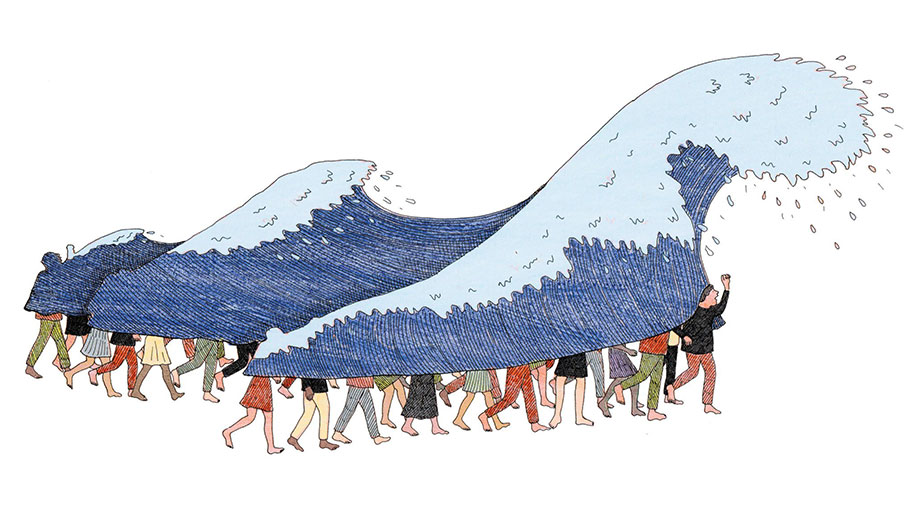Illustration by Marion Fayolle
By Kenneth T. Andrews —
Do protests and social movements matter? Do they really bring about change?
Answering this question is tricky. It’s not obvious, for example, how much the recent shift to the right in American politics reflects the efforts of the Tea Party movement and how much it reflects deeper developments such as increasing racial hostility and negative reactions to globalization. Sometimes a movement matters far less than the social, economic and political forces that give rise to the movement itself.
When social scientists do uncover evidence of a movement’s influence, we have tended to focus on three main pathways by which movements gain power: cultural, disruptive and organizational. On its own, each pathway turns out to be limited in its effect. But movements that have managed to combine all three, such as the civil rights movement in the 1950s and ’60s, have had lasting impact.
Movements are said to exercise “cultural” power when they shape public opinion, language and everyday behavior. Part of what social movements do is create new ideas that challenge the status quo. Some of these ideas never go anywhere, but others take hold even among people who never participate in the movement. People didn’t talk about “the 99 percent” as a way of personalizing the issue of economic inequality before the Occupy movement popularized the phrase. Afterward, the conversation changed: As the sociologists Sarah Gaby and Neal Caren showed in a 2016 article, discussion of inequality in mainstream newspapers increased threefold in the period after Occupy.
But cultural power is not everything. It is difficult to change people’s attitudes about controversial issues. Movements risk “preaching to the choir.” Those opposed to a movement’s goals or hostile to its constituency may also respond by deepening their opposition or hostility. You see this in the polarized reactions of fans to the national anthem protests in the National Football League. In addition, cultural power may change public opinion or discussion of an issue but not translate into other kinds of lasting institutional changes, as was the case with Occupy.
Movements have “disruptive” power when they make it more costly for people to support the status quo. Students in the civil rights movement used sit-ins to increase the everyday costs of doing business until business owners capitulated to their demands. In a 2015 study, the sociologist Michael Biggs and I found that sit-ins could prompt business owners even in neighboring cities to desegregate, because they feared the costs of facing future protesters. Disruption can also signal the depth of participants’ commitment to a cause and the movement’s capacity to withstand repression.
The drawback of disruptive power is that it often inspires counterattacks. The first order of business for elites and authorities facing disruptive protest is to bring it to an end. Some may meet protesters’ demands; some will crack down on protest. Others do both. One week Jerry Jones, the owner of the Dallas Cowboys, was kneeling in apparent solidarity with players seeking to bring attention to racial injustice; the next week he threatened to bench any player who knelt.
Finally, movements build power through organizing. Strong organizations make possible the sort of sustained participation that supports a protest’s agenda for the long haul. In recent years, the Tea Party has provided an example of how movements can use organizational power to help bring about social and political change. The political scientists Theda Skocpol and Vanessa Williamson have analyzed how Tea Party activists, building on the disruptive power of the movement’s initial protests in 2009, established local organizations, supported candidates who shared the movement’s ideals and helped transform the Republican Party.
Organizational power faces its own challenges, though, including the difficulty of sustaining meaningful participation. Staging the occasional protest and raising money are one thing; developing leaders and building constituencies are another. Despite substantial resources and hundreds of organizations, the environmental movement, for example, has not generated the sort of participation sufficient to meet the environmental challenges we face. This failure reflects a larger trend of professional advocacy groups that connect to their supporters primarily through fund-raising appeals.
How does a movement manage to combine cultural, disruptive and organizational power? In some cases, this is accomplished through a division of labor. For example, in the civil rights movement, prominent leaders linked the language of rights, the symbols and rituals of the black church, and the Gandhian approach to civil disobedience; student activists fueled disruption through direct-action protests; and the National Association for the Advancement of Colored People, with hundreds of local organizations and leaders across the country, challenged the powers supporting the status quo in their communities and through the courts.
Over the past year, people have taken to the streets and sought to establish or revitalize organizations to resist the Trump presidency and advance broader social change. To capitalize on the energy and urgency of the moment, leaders and activists should look to build a movement that generates new sources of cultural, disruptive and organizational power.















